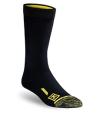IR Patches: Critical Identification Tools for Police and Military Operations
In modern policing and military operations, particularly those conducted at night or in low-light conditions, the ability to rapidly and accurately identify friendly personnel is essential. Infrared (IR) patches are a key part of Identification Friend or Foe (IFF) systems and have become standard issue in many tactical environments. Designed for use with night vision equipment, these patches enable covert but effective identification without compromising operational security.
This article outlines how IR patches work, their practical applications in the field, and the importance of selecting patches manufactured with genuine, high-performance IR-reflective materials.
What Are IR Patches?
IR patches are made using materials that reflect light in the near-infrared spectrum, typically between 800 and 1000 nanometres. When illuminated by an IR light source, such as a torch or aiming laser, they reflect this light in a way that is highly visible through night vision devices (NVDs) but remains invisible to the naked eye.
IR patches are commonly shaped as national flags, call signs, blood types, or unit insignia. They are usually Velcro-backed or sewn onto uniforms, helmets, or load-bearing equipment. Their design is intentionally subdued in visible light to maintain camouflage during the day.
Why IR Patches Are Used by Police and Military Forces
Night-Time Identification
One of the primary uses of IR patches is to reduce the risk of friendly fire during night operations. When used in conjunction with night vision devices and IR illumination, IR patches allow personnel to quickly identify friendly units without the use of visible light or radio communication. This is critical during urban operations, reconnaissance, and night raids.
Operational Stealth
IR patches are passive and do not emit any light on their own. They only reflect IR light when it is projected onto them. This makes them ideal for situations requiring stealth, as they are completely undetectable without night vision equipment and IR illumination.
Inter-Agency Coordination
In joint-force operations involving military and police tactical units, IR patches improve coordination and help prevent misidentification. This is particularly relevant during counter-terrorism operations, public order deployments, or large-scale incident responses where personnel from different organisations operate together under low visibility.
Airborne and Drone Recognition
IR patches are also highly effective in operations supported by aircraft or drones equipped with IR or FLIR sensors. They allow aircrews and remote operators to locate and confirm the identity of ground personnel quickly and accurately.
Not All IR Patches Are Equal: Material Matters
One of the most important considerations when sourcing IR patches is the quality of the materials used. Unfortunately, the market has seen a rise in poorly manufactured or falsely advertised patches that claim to be IR reflective but fail to perform when tested under operational conditions.
Common issues with inferior IR patches include:
- Low reflectivity or minimal visibility under IR illumination
- Use of non-IR-compliant materials, such as standard vinyl or printed graphics
- Lack of durability or resistance to weather and wear
Using substandard patches poses a significant operational risk. Personnel may become difficult or impossible to identify under night vision, undermining the entire purpose of the IFF system.
When procuring IR patches, it is essential to verify that they are manufactured using genuine IR-reflective film or laminate and are tested under field conditions. Reputable manufacturers will provide evidence of testing and operational use, often having supplied to military or emergency services under contract.
How IR Patches Are Used in Practice
In the field, IR patches are typically mounted to helmets, shoulders, plate carriers, or rucksacks to ensure visibility from key angles. When needed, an IR light source is activated — either manually or from an integrated device — and the patch reflects the light clearly to observers using night vision equipment.
To those with NVGs, the patch appears brightly illuminated, allowing for instant identification. To observers without night vision, including potential adversaries, the patch remains unseen.
This makes IR patches a discreet but highly effective identification method that enhances both safety and coordination during operations.
Use in Tactical Police Units
Specialist police teams, such as armed response units and counter-terrorism squads, frequently operate in low-light conditions where IR patches offer clear advantages. From surveillance operations and building clearances to moorland searches or rapid deployments supported by drones, IR identification reduces the risk of crossfire and improves team awareness.
Integration with UAV and Air Support
Ground teams marked with IR patches can be identified from above by helicopters and UAVs fitted with night vision or thermal optics. This capability is increasingly valuable in modern policing and military applications, supporting tasks such as:
- Aerial extractions
- Close air support
- Drone-based overwatch and identification
Sourcing High-Quality IR Patches
Contact Left Ltd offers a full range of high-performance IR patches manufactured in the UK by UK Outdoor Manufacturing (UKOM). These patches are in active service with British Police and Armed Forces and are constructed using genuine IR-reflective materials tested for field use.
Available in a variety of tactical colours including Crye Multicam, Ranger Green, Black, and more, our patches can be customised with flags, callsigns, blood types, or unit insignia to meet specific requirements.
All products are compliant with relevant operational standards and are available for immediate delivery or bulk ordering.
contact us directly at sales@cldistribution.co.uk
Conclusion
IR patches are an essential tool for modern police and military personnel. When used correctly, they offer a low-profile, highly effective method of friendly identification in night-time and low-visibility environments. However, effectiveness depends entirely on the quality of materials used.
Choosing genuine, tested IR patches from a trusted supplier is critical to ensuring they function reliably when it matters most. In operational settings, there is no room for compromise.












